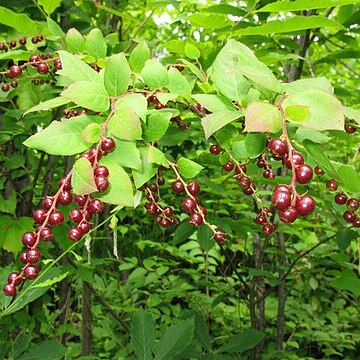Shrubs deciduous, 1–3 m tall. Twigs terete, angled, densely pubescent and with scattered glandular hairs, glabrescent; bud scales inconspicuous. Leaves scattered; petiole 1–3 mm, pubescent, with intermixed glandular hairs; leaf blade ovate, elliptic, or oblong, 2.5–8 × 1.2–4.5 cm, papery, abaxially setose or glandular setose on veins, otherwise appressed-setose or glabrous, adaxially pubescent on veins, otherwise appressed-setose or glabrous, secondary veins (5–)7 or 8 pairs, secondary and fine veins raised abaxially, slightly raised or flat adaxially, base cuneate, broadly cuneate, or rounded, margin plane, denticulate, glandular setulose at tips of teeth, apex acute. Inflorescences terminal, racemose, 3–6 cm, pubescent, with intermixed glandular hairs, (1–)9–17-flowered; bracts ovate-lanceolate to linear, 2.5–7 mm. Pedicel ca. 1.5 mm, glandular pubescent. Hypanthium glandular pubescent; calyx lobes triangular, ca. 1.5 mm, ciliate. Corolla pinkish, campanulate, 3–5 mm, glabrous; lobes ca. 0.5 mm. Filaments ca. 1.5 mm, pilose in upper part; anthers ca. 1.7 mm, thecae without spurs; tubules ca. 1/2 as long as thecae. Berry 10-pseudoloculed, dark purple, subglobose, 0.7–1 cm in diam. Fl. May–Jun, fr. Jul–Oct.
More
A compact upright shrub. It loses its leaves during the year. It grows from 1-3 m tall. The older branches and slender and dark brown. The leaves are oval or curved and slightly pointed at the tip and base. They are 3-7 cm long by 2-4 cm wide. They are paler green underneath. There can be coarse hairs on the upper surface. The leaves turn bright red in autumn. The flowers are 3-5 mm long with downy flower stalks. The flowers occur as many together along stalks 4-6 cm long. These are at the ends of young shoots. The flowers are bell shaped and pale brown or red. The fruit are round berries 8 mm across. They are black.

